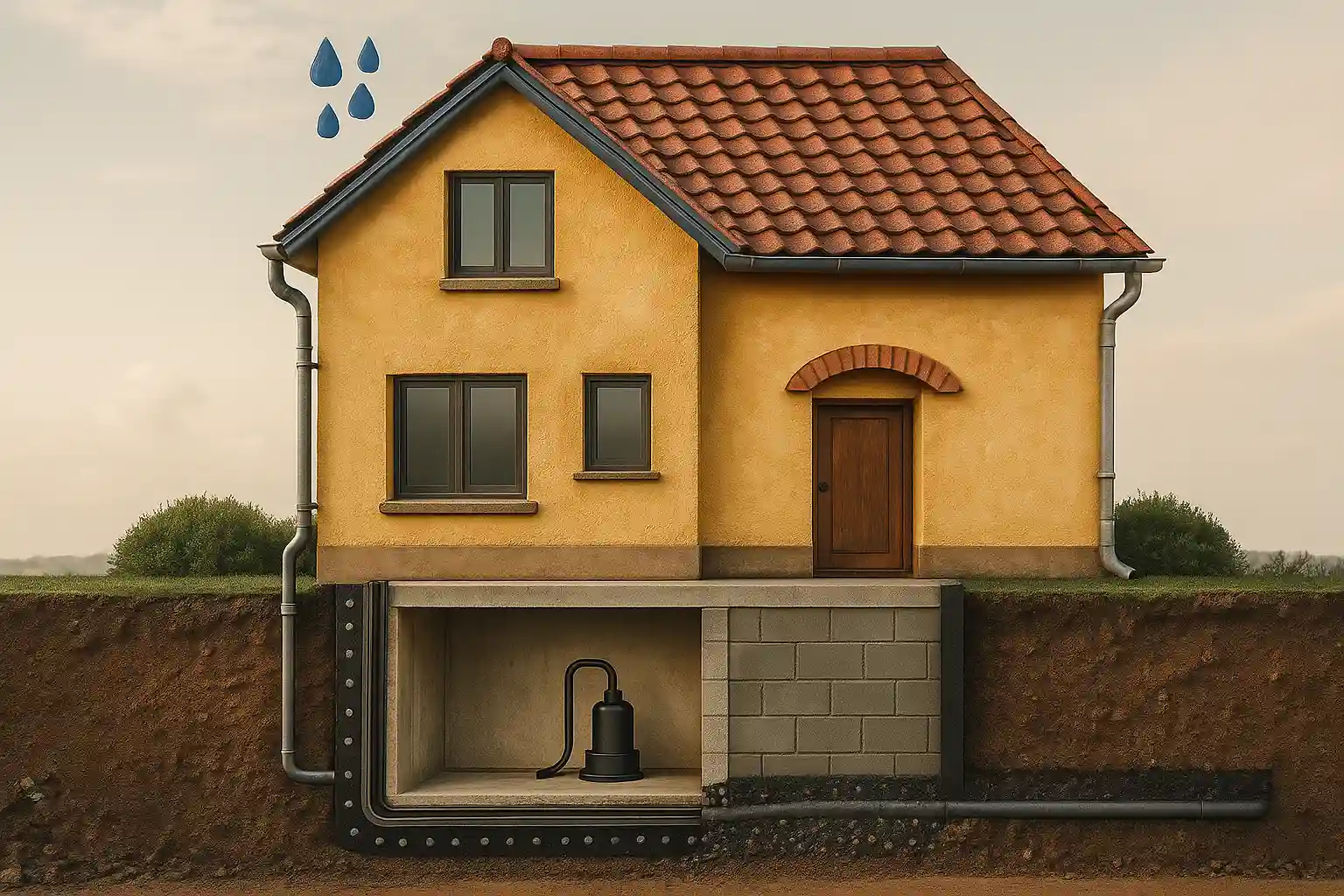Basement Flooding Prevention
Why Your Current Strategy Probably Won't Work When You Need It Most
If you’ve lived in your home for more than a few years, you’ve probably noticed something: storms are getting more intense, and your basement protection isn’t keeping up. According to Ohio State Waterproofing, approximately 60% of homes in the United States experience basement leaks, making this one of the most common problems homeowners face. What’s worse is that the methods your parents used to keep basements dry simply don’t work against today’s flooding challenges.

Table of Contents
Why Today’s Flooding Problems Are Different
Waterproofing Methods That Actually Last
Drainage Systems That Handle Real Water Problems
Getting Professional Help Without Overpaying
Emergency Planning for When Things Go Wrong
The Real Cost of Prevention vs. Cleanup
Final Thoughts
TL;DR
Climate change and crumbling infrastructure have created basement flooding scenarios that old-school prevention can’t handle. New waterproofing technologies like self-healing membranes and smart monitoring systems work better than traditional approaches. Effective drainage needs both interior and exterior systems working together, not just a basic sump pump. Professional assessment is crucial because every basement faces unique risks. Emergency planning and proper insurance are essential backups. Prevention typically costs $8,000-$15,000 while flood damage averages $15,000-$25,000. You can implement protection in phases to spread costs while building complete coverage over time.
Why Today's Flooding Problems Are Different
Today’s basement flooding challenges have evolved dramatically. Climate change, crumbling city infrastructure, and modern construction practices create new vulnerabilities that require completely different approaches to keeping your basement dry.
Extreme Weather Is Changing Everything
We’re dealing with storm patterns that would have been considered impossible twenty years ago. Your grandfather’s sump pump setup wasn’t designed for the 3-4 inches of rain that can fall in an hour during these intense weather events.
Recent severe weather events show just how inadequate traditional flood prevention has become. “Basement water issues, such as leaks or flooding, can arise for various reasons. A leading culprit is intense rainfall from storms—something many homeowners are dealing with right now due to the severe weather and widespread flooding that has devastated much of the country” according to House Beautiful’s recent coverage of nationwide flooding issues.
Effective basement protection now means planning for worst-case scenarios, not average conditions. This means bigger pump capacities and waterproofing that can handle sustained pressure from completely saturated soil around your foundation.
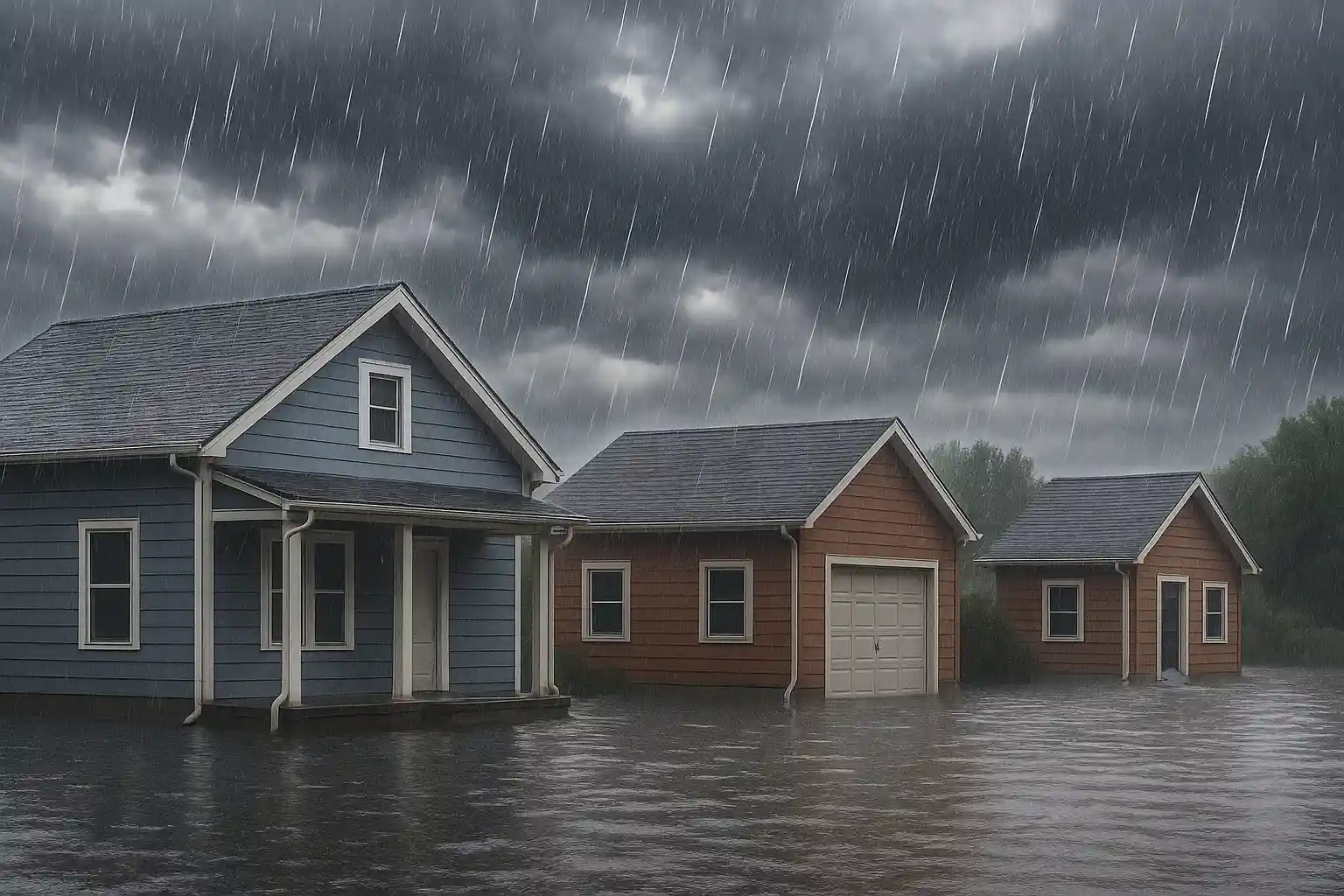
Living in urban areas creates its own set of problems. All that concrete and asphalt doesn’t absorb water – it channels everything toward your foundation at high speed. The heat island effect actually changes how storms behave over cities, often making rainfall more intense right where you have the least natural drainage.
Understanding winter storm roof protection strategies helps you recognize how roof-level water management directly impacts basement flooding risks. When roofing systems get compromised, they channel excessive water toward foundation areas during intense storms.
City Infrastructure Is Failing
Most city sewer systems were built decades ago for populations and rainfall patterns that no longer exist. When these systems get overwhelmed – and they will – that water has to go somewhere. Often, it’s straight up through your floor drains.
Installing backwater valves isn’t optional anymore. A homeowner in Cleveland learned this the hard way when sewage backed up through his floor drain during a moderate storm. Despite having a functioning sump pump and sealed foundation walls, century-old city sewers couldn’t handle the runoff. A $300 backwater valve could have prevented $18,000 in cleanup costs.
Modern Construction Creates New Problems
Today’s construction materials and methods create settling patterns that open up water pathways in ways that weren’t common with older building methods. Building codes now require egress windows in basements, which is great for safety but creates new entry points for water.
These window wells and stairwells need specialized waterproofing techniques that address these specific vulnerability points. Regular foundation monitoring isn’t just recommended anymore – it’s necessary to catch developing cracks before they become major problems.
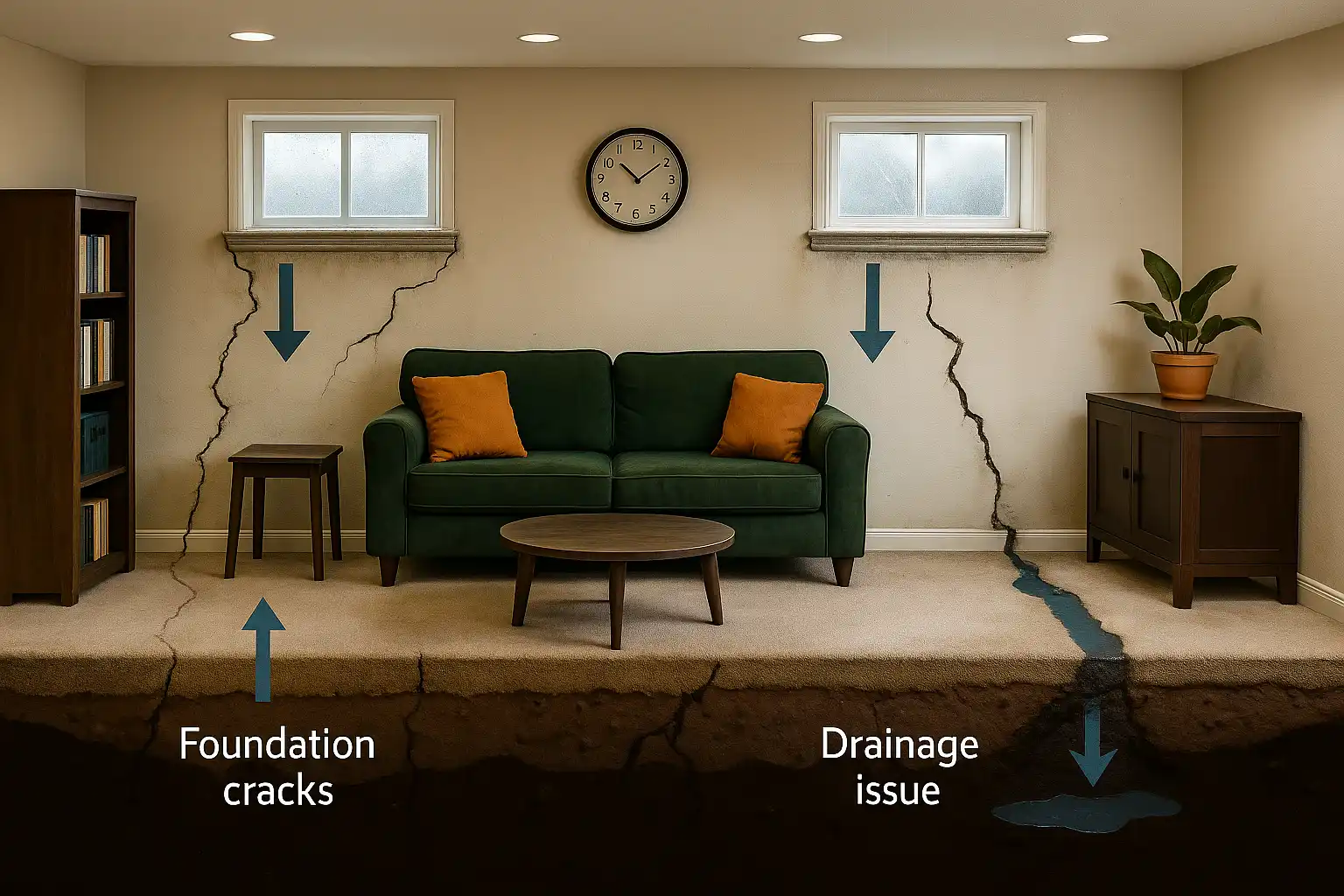
Waterproofing Methods That Actually Last
Revolutionary waterproofing materials are transforming basement protection. We’re talking about advanced polymer technologies, self-healing membranes, and smart monitoring systems that provide superior longevity compared to traditional tar-based approaches that fail after a few years.
Membranes That Fix Themselves
Modern waterproofing membranes use advanced polymers that actually respond to damage and repair themselves. When a tiny crack develops, the material flows to fill the gap without any intervention from you.
This technology sounds like science fiction, but it works. Professional installation is non-negotiable with these systems, but you’re looking at decades of maintenance-free protection. The upfront cost is higher, but the long-term value makes traditional waterproofing look primitive.
Crystalline waterproofing technology actually uses water exposure to strengthen the barrier. When moisture contacts the treated concrete, it triggers crystal formation that fills pores and creates an impermeable seal that gets more effective over time. Minor cracks trigger the same crystal formation process, essentially making the concrete self-repairing.
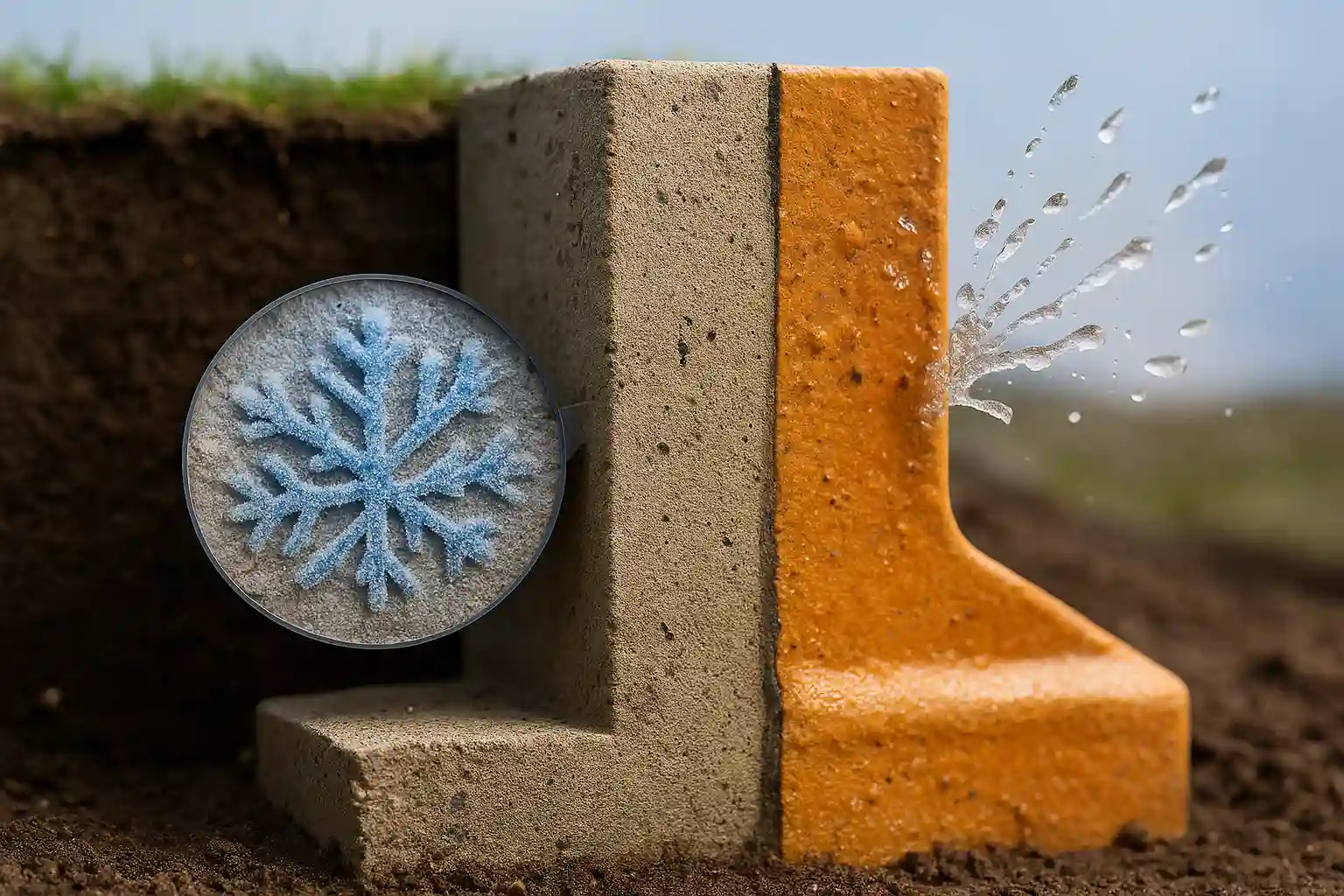
Smart Systems That Give You Warning
Internet-connected sensors and monitoring systems provide real-time basement condition tracking. These systems enable you to take action before flooding occurs, completely changing how we approach basement protection.
Wireless water detection has evolved way beyond simple alarms. Current systems create networks of sensors throughout your basement that communicate with your smartphone and can automatically trigger pumps, ventilation, or other protective measures.
The most advanced systems now integrate local weather forecasting with your basement’s historical data to predict flooding risks. You can get alerts days before severe weather hits, giving you time to activate backup systems or move valuables.
Drainage Systems That Handle Real Water Problems
Modern basement flooding prevention requires drainage approaches that manage water from multiple sources through coordinated interior and exterior systems. This means optimized French drains, integrated gutter systems, multi-stage sump pump configurations, and interior perimeter drainage working together.
Exterior Systems That Work Together
Comprehensive exterior drainage coordinates with roofing and landscaping to prevent water from reaching basement areas. The key is creating a unified approach that addresses water at every stage of its journey toward your foundation.
Most French drains fail because they’re installed wrong. Proper installation requires excavating to footer level, using the right slope calculations, and incorporating materials that prevent soil infiltration while allowing water flow. The key is connecting these systems to drainage that actually moves water away from your foundation, not just dumps it where it can seep back.
Standard gutters weren’t designed for the rainfall intensities we’re seeing now. Upgrading to larger capacity gutters and adding strategic downspout placement prevents roof water from overwhelming your foundation drainage systems. Underground drainage extensions are crucial – surface splash blocks don’t cut it anymore.
Learning about flash flood roof protection measures shows how proper roof drainage integration with basement waterproofing creates comprehensive water management that prevents both roof damage and basement flooding during extreme weather.
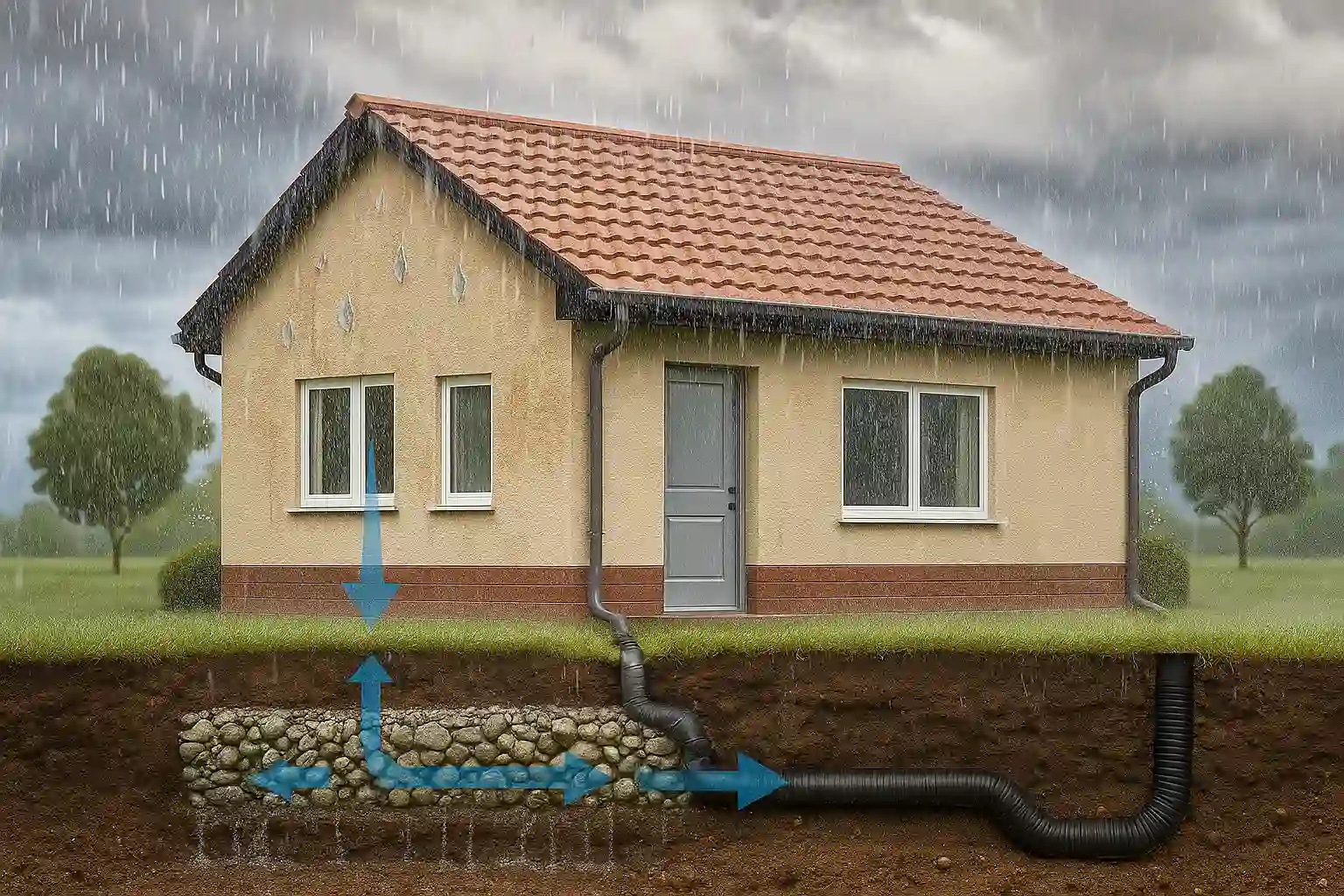
Interior Systems That Provide Real Backup
Advanced interior drainage systems provide reliable basement protection through redundant pumping systems and comprehensive water collection methods. These serve as your last line of defense when exterior protection gets overwhelmed.
Single sump pump installations are asking for trouble. Multi-stage configurations with primary and backup pumps ensure continuous operation even during power outages, which often happen during severe weather.
A homeowner in Minneapolis learned this lesson when their single sump pump failed during a spring thaw. The basement flooded with 18 inches of water, causing $22,000 in damage. Installing a dual-pump system with battery backup would have cost $2,800 and prevented the entire disaster.
Interior perimeter drain systems create a last line of defense by collecting water that makes it past exterior protection. These systems integrate with waterproof flooring and wall treatments to provide comprehensive interior protection. Professional installation is critical because these systems need to tie into your sump pump setup and maintain proper drainage slopes.
The effectiveness of proper drainage becomes critical when you consider that “approximately 98% of basements in the country will experience some form of water damage during their lifespan” according to Basement Defender’s analysis of water damage statistics.
Essential Sump Pump System Components:
Primary pump with adequate capacity (minimum 1/3 HP for most basements)
Battery backup pump system with 12+ hour runtime
Water-powered backup for extended outages
Smart controller with alternating pump operation
High-water alarm system
Proper discharge line with freeze protection
Check valve to prevent backflow
Sealed sump pit with tight-fitting lid
Ground fault circuit interrupter (GFCI) protection
Annual maintenance schedule
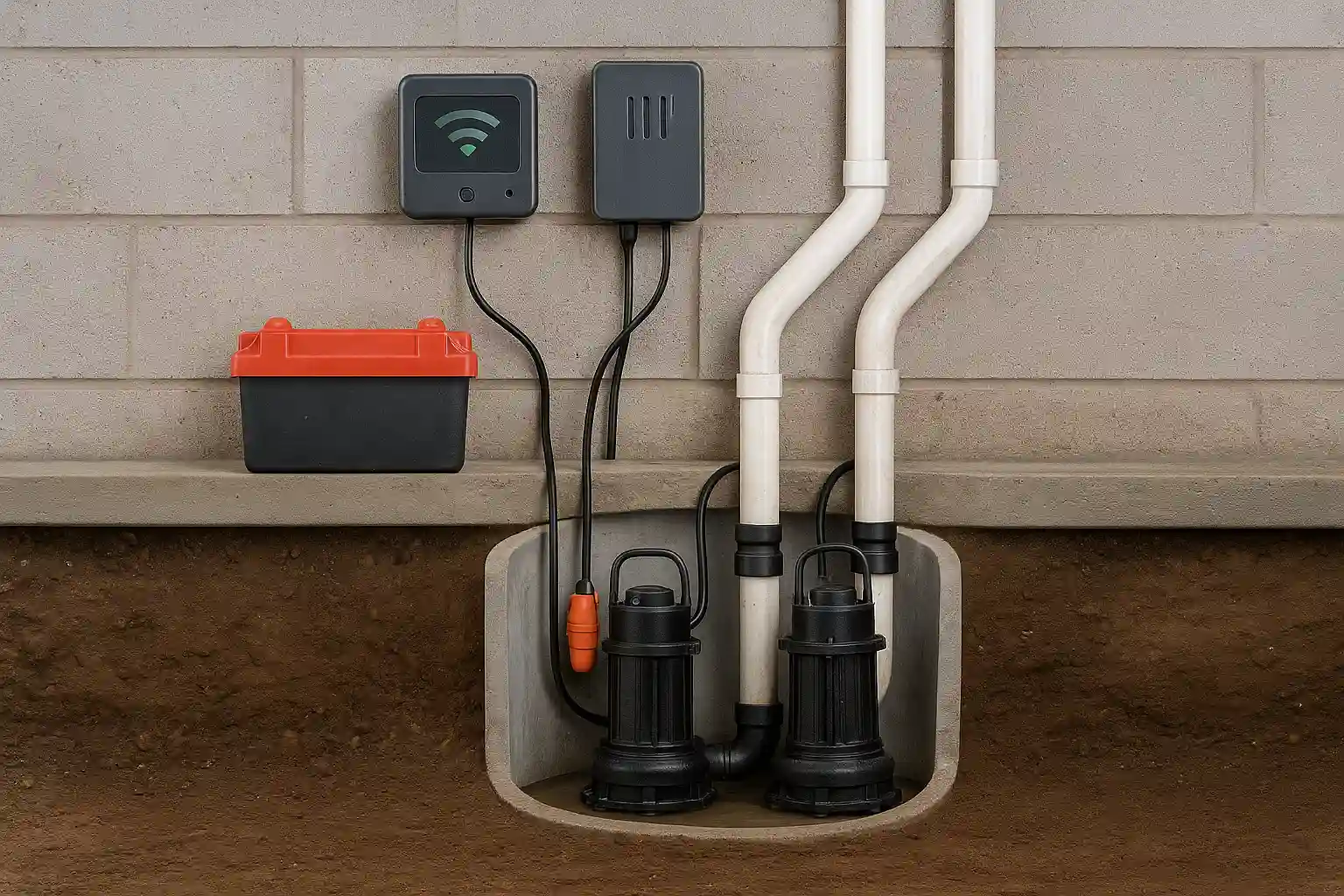
Getting Professional Help Without Overpaying
Effective basement flooding prevention requires professional evaluation using advanced diagnostic tools and local knowledge to identify specific risks and implement customized solutions. This includes pressure analysis, foundation integrity assessment, and utility entry evaluation.
Assessments That Find Real Problems
Professional assessments use advanced diagnostic tools and local knowledge to identify all potential water intrusion sources and recommend prioritized prevention strategies. Generic solutions fail because they don’t account for your specific conditions.
Hydrostatic pressure analysis isn’t something you can DIY effectively. Professional evaluations include soil testing and groundwater level assessment that determine exactly what your foundation is up against. This analysis directly informs decisions about waterproofing methods, drainage requirements, and pump system specifications.
Professional inspectors use thermal imaging and moisture meters to identify problems that aren’t visible to the naked eye. These hidden issues often become major failure points during severe weather events. Foundation integrity assessment goes beyond obvious cracks to identify areas where settling, material degradation, or construction defects create future vulnerability.
Professional assessment becomes even more critical when considering how roof damage can compound basement flooding risks. Understanding quick roof leak response procedures helps you recognize the connection between roof-level water intrusion and basement flooding.
Utility and service entries are often overlooked water intrusion points. Every penetration through your foundation walls or floor represents a potential failure point that needs proper sealing. Professional assessment includes examining electrical, plumbing, and HVAC entries with specialized equipment that can detect compromised seals before they fail.
When you’re ready to move forward with professional basement waterproofing, remember that water management starts at the top of your home. Daniel Hood Roofing Systems has completed over 10,000 roofing projects with lifetime no-leak warranties, creating the first line of defense against water intrusion. Their standing seam metal roofing systems with hidden fasteners and mechanical seaming ensure roof water is properly channeled away from your foundation, reducing the load on your basement waterproofing systems.

Emergency Planning for When Things Go Wrong
Even with comprehensive prevention systems, emergency preparedness and rapid response protocols are essential. This includes water extraction procedures, electrical safety measures, proper insurance coverage understanding, and documentation strategies to minimize damage and ensure quick recovery.
Response Plans That Work Under Pressure
Water extraction needs to happen immediately – we’re talking hours, not days. Professional-grade equipment should be accessible through pre-arranged rental agreements or emergency service contracts because waiting for availability during a crisis costs you exponentially more in damage.
The 24-48 hour window is critical for preventing mold growth and structural damage. Having extraction equipment identified and accessible before you need it makes the difference between manageable cleanup and major renovation.
First rule of basement flooding: turn off the power before you do anything else. If you’re not sure how, call an electrician. It’s not worth the risk. Never assume electrical systems are safe in flooded basements, even if power appears to be off.
Municipal programs are recognizing the critical importance of basement flood prevention. “City council is expected to hike the value of rebates available to Toronto homeowners who install flood prevention devices for their basements” with subsidies increasing from $3,400 to $6,650, according to Toronto Today’s coverage of the city’s enhanced basement flooding protection program.
Emergency preparedness extends beyond basement considerations. Learning about roof strengthening for storm season helps you understand how proper roof preparation reduces water intrusion risks that could overwhelm basement protection systems during severe weather.
Insurance Reality Check
Here’s a reality check: standard homeowner’s insurance typically excludes flood damage. Separate flood insurance is essential for comprehensive protection, but understanding coverage limitations helps you make informed decisions about additional protection needs.
The definitions of “flood” versus “water damage” in insurance policies can be surprisingly narrow. What you think is covered might not be, making it crucial to understand exactly what protection you have before you need it.
Detailed basement inventories with photos and receipts aren’t just good organization – they’re essential for insurance claims. Regular updates reflecting changes in stored items and their values ensure proper compensation when losses occur.
A family in Phoenix discovered their insurance gap when monsoon flooding damaged their finished basement. Despite having comprehensive homeowner’s insurance, the $19,000 in damage wasn’t covered because it was classified as “surface water flooding.” They had to pay out of pocket for repairs while fighting the insurance company for eight months.
Understanding insurance coverage becomes even more critical when you consider that “water damage restoration costs carry significant implications for US homeowners. On average, two-thirds (66%) of their wealth is tied to their homes” according to Basement Defender’s analysis of homeowner financial vulnerability.
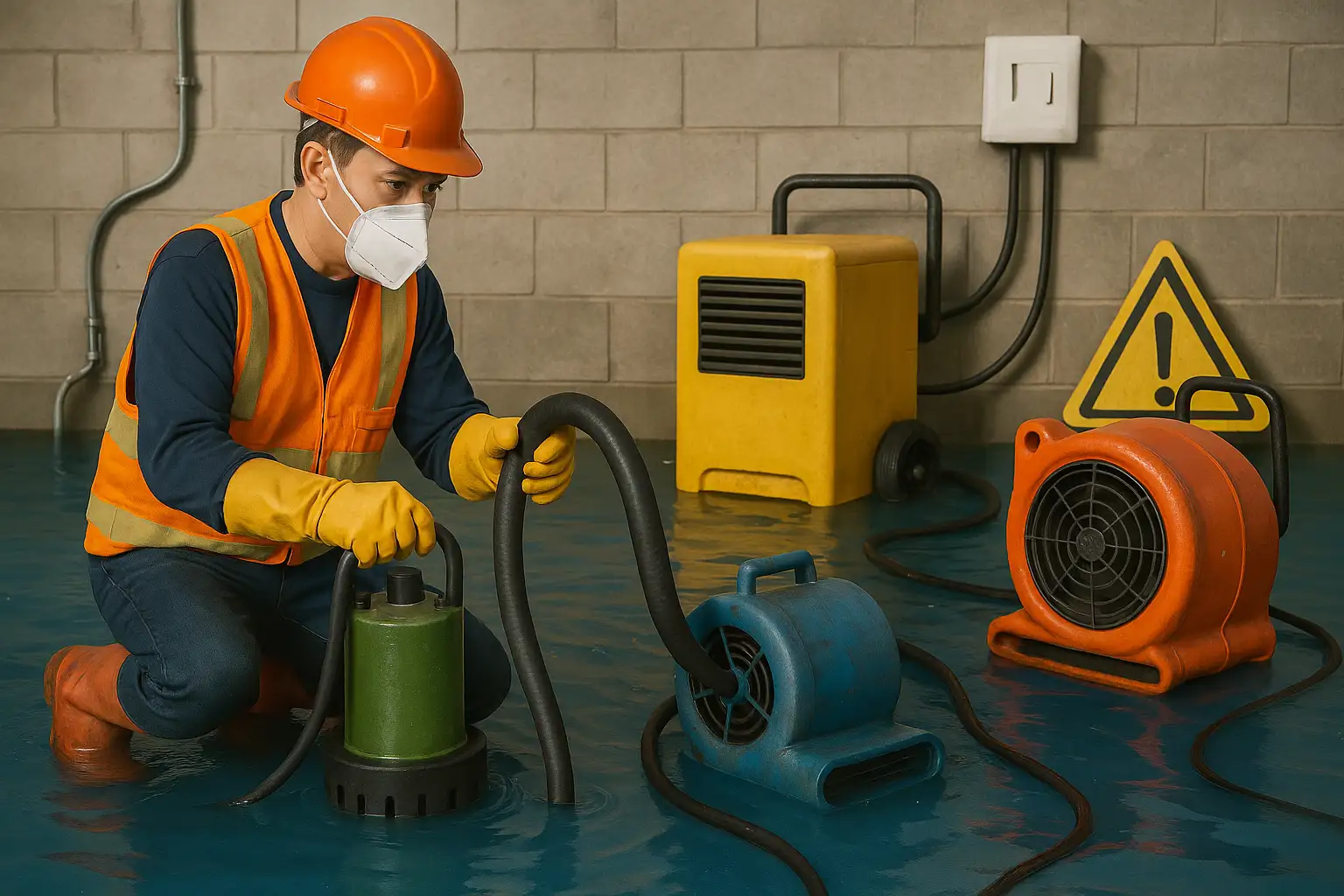
The Real Cost of Prevention vs. Cleanup
Here’s the thing about money – fixing a flood costs about twice what preventing it does. Most prevention runs $8,000 to $15,000. Most flood damage? $15,000 to $25,000, and that’s if you’re lucky.
Numbers That Tell the Real Story
Average basement flooding events hit homeowners for $15,000-$25,000 in damage and repairs. That’s not including the hidden costs like temporary housing, lost work time, and items that can’t be replaced at any price.
Comprehensive prevention systems typically run $8,000-$15,000 for professional installation. The math is straightforward – prevention costs less than cleanup, and you only have to do it once if you do it right.
Professional waterproofing systems don’t just protect your investment – they enhance it. Homes with documented flood prevention systems command higher resale prices and attract more buyers in competitive markets. Buyers are increasingly savvy about water damage risks The financial benefits of comprehensive water management extend beyond basement protection to overall property value preservation. Understanding leaky roof dangers helps homeowners recognize how water intrusion at any level can compromise property values, making integrated protection from roof to foundation a smart investment in long-term property worth.
Building Protection Over Time
You don’t have to implement everything at once. Prioritizing critical systems like sump pumps and exterior drainage provides immediate protection while you plan for advanced monitoring and backup systems.
Start with the systems that address your biggest risks, then expand capabilities as budget allows. The priority order makes sense: address immediate water intrusion sources first, install primary sump pump systems, implement exterior drainage improvements, add backup systems and monitoring technology, then upgrade to advanced waterproofing membranes and smart systems.
Phased Implementation Priority:
Phase 1 – Critical Systems (Immediate)
Primary sump pump installation
Backup power system
Basic moisture detection
Major crack sealing
Phase 2 – Exterior Protection (3-6 months)
French drain installation
Gutter system upgrades
Downspout extensions
Foundation grading improvements
Phase 3 – Advanced Systems (6-12 months)
Smart monitoring network
Backup sump pump
Interior perimeter drainage
Advanced waterproof membranes
Phase 4 – Premium Features (12+ months)
Predictive analytics integration
Whole-house water management
Emergency response automation
Professional maintenance contracts
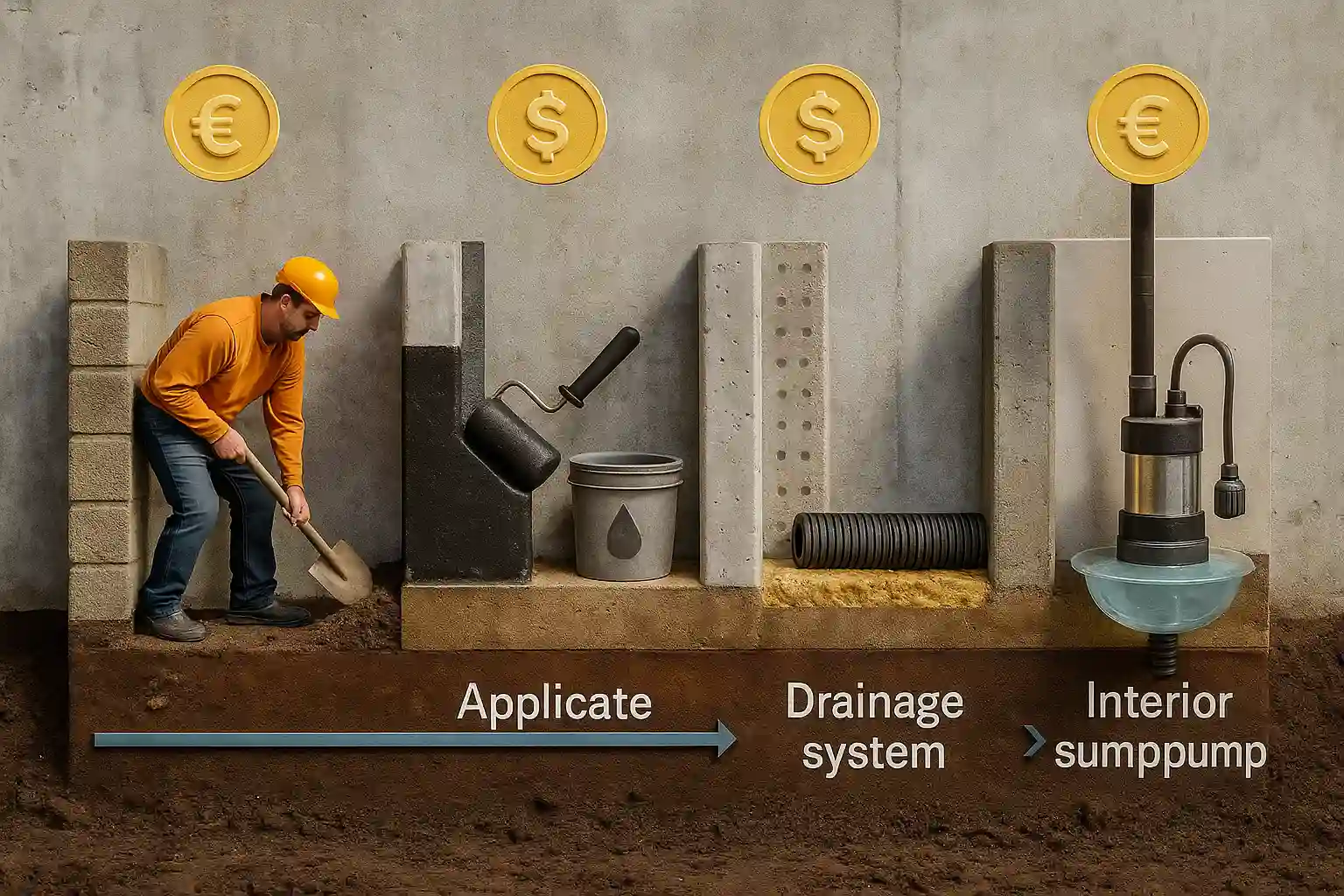
Final Thoughts
Basement flooding prevention isn’t the same challenge it was even a decade ago. Climate change, aging infrastructure, and modern construction practices have created risks that traditional approaches simply can’t handle effectively. The good news? Technology has evolved to meet these challenges with solutions that actually work long-term.
The financial case for prevention is compelling – spending $8,000-$15,000 on comprehensive protection beats paying $15,000-$25,000 for flood damage every time. More importantly, modern prevention systems protect your family’s safety and peace of mind in ways that emergency cleanup never can.
Professional assessment remains crucial because every basement faces unique risks that generic solutions won’t address. Whether it’s pressure from your specific soil conditions, municipal sewer backup risks, or construction-related vulnerabilities, customized solutions provide protection that actually works when you need it most.
Smart implementation through phased approaches makes comprehensive protection accessible regardless of budget constraints. Starting with critical systems and building protection over time ensures immediate risk reduction while working toward complete coverage.
Remember that effective water management starts at your roofline and works down to your foundation. Understanding common types of roofing damage helps homeowners recognize early warning signs that could lead to basement flooding if left unaddressed. When you’re ready to implement comprehensive protection, consider how superior roofing systems integrate with basement waterproofing to create complete water management solutions that protect your home at every level.
The bottom line? Basements flood differently now than they did 20 years ago. If your prevention strategy is older than your smartphone, it’s probably time for an update.
